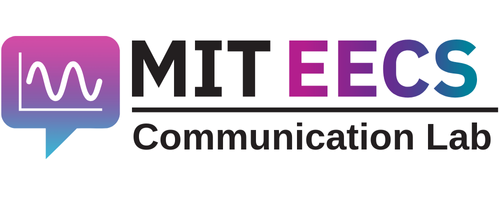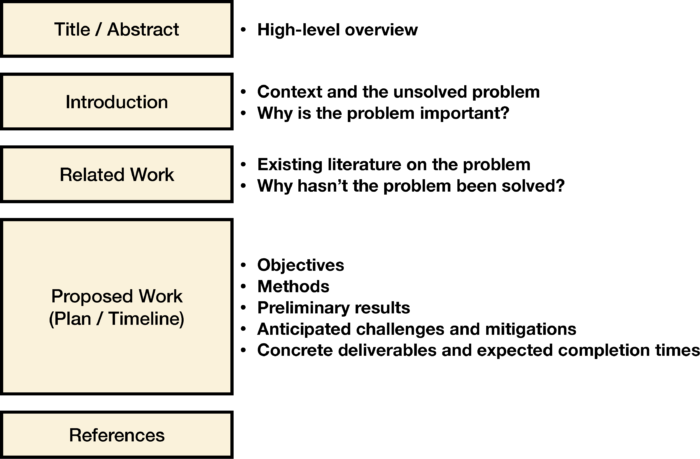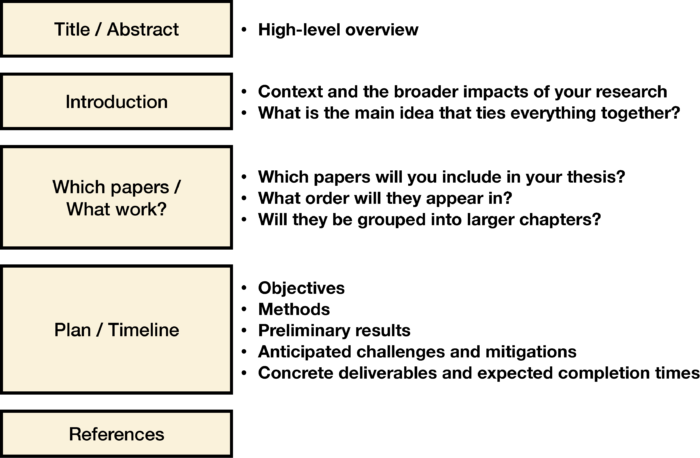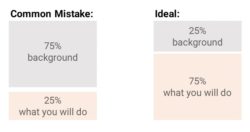Criteria for Success
A thesis proposal should allow your audience to understand the topic of your project, the goals of the work, and the expected timeline to completion. To be successful, a thesis proposal should:
- follow departmental guidelines for thesis proposal content, structure, and formatting.
- provide necessary background for understanding the work that you propose.
- answer the Heilmeier questions to concretely explain what you are trying to do and how you will achieve it.
- include a timeline for the expected remaining work in the thesis, including tasks and dates of completion.
Structure Diagram
As with all communication projects, the right length for a thesis proposal is “however long it takes to convey your message effectively.” While the goal should be effectiveness rather than length, a general rule of thumb is to consider 8-12 pages for an MEng or SM proposal and 10-20 pages for a PhD proposal.
The main components of a thesis proposal are:
- title and abstract,
- introduction that motivates the proposed work,
- related and/or preliminary work, and
- proposed future work, including a timeline to complete that work.
There should also be a references section that contains all necessary citations. The following diagrams provide examples of potential thesis proposal organizations and their relative size. Note that the section headings as well as the size and ordering of the sections may be flexible.
Always be sure to follow the most up-to-date department guidelines.
MEng/SM Proposal
For MEng thesis proposals, the MIT EECS guidelines for MEng thesis proposals suggest that these documents should be between 1500-2500 words.
For SM proposals, the MIT EECS guidelines for SM and PhD thesis proposals indicate that the research plan should also include a list of principal equipment and facilities needs and the places which will supply these needs.
PhD Proposal
For a PhD thesis proposal, it is important to think about how the work that will go into your thesis ties together. What is the main idea that your work supports?
Purpose
A thesis proposal serves as a contract between you and your thesis committee. The document should demonstrate the feasibility and merit of your proposed project and clearly define the work you will have to accomplish to complete your degree. This assures your committee that you have agreed to an acceptable level of research and protects you against future attempts to increase your workload. For this reason, it is advisable to have a thesis proposal written and signed relatively early in the degree process.
Thesis proposals also provide an opportunity for you to sharpen your research by stepping back and looking at the big picture. By carefully planning your research, you will focus on the most important questions and the most effective ways to answer them.
Analyze Your Audience
The primary audience of your thesis proposal is your thesis committee (for SM and MEng students, the committee is simply your advisor), who will serve multiple roles: they are coaches who support your success and gatekeepers who ensure that degrees are only granted for sufficient quality of work. In their role as coaches, committee members want to know that your project is feasible and worth pursuing and that you are prepared to undertake it. In their role as gatekeepers, committee members want to see that your project showcases mastery of a subject and solves an important and novel problem.
In the future, other students may also read your proposal as a reference to build on your work or use it as a model for their own. Therefore, your proposal should include both a concrete description of your work and the necessary background to understand the topic.
Skills
Answer the Heilmeier Questions
Before you start writing your thesis, consider the main motivations of the work and your approach. One great way to start brainstorming for your thesis proposal is to answer the Heilmeier questions for your own work.
In the 1970’s, the director of DARPA (George Heilmeier) developed a list of questions, known as the Heilmeier Catechism, to produce and select productive research proposals. To outline the content of your proposal, start by answering the following questions:
- What problem needs solving? What are you trying to do?
- How is it done today? What are the limitations of the current practice?
- What is new in your approach and why do you think it can succeed?
- Assuming you are successful, what difference does it make? Who cares and why?
- How much time/money/risk will it take?
- How will you (periodically) measure success?
You have many available resources for answering the Heilmeier questions. Start with your research advisor; they can point you to the most relevant literature, help identify productive research directions, and refine your plan for feasibility and scope. Other group members as well as past papers and theses from your group may also be able to help.
Emphasize your contribution
A thesis proposal should emphasize the problem and proposed work. Try to spend about 25% of your proposal on background and 75% on what you propose to do and a timeline to completion.
Include a timeline for completion
A timeline is a required component of almost any project proposal and should show that you have thought through the overall project goals and how to achieve them in accomplishable steps. The timeline should be granular enough to be meaningful (typically, a few months at a time) but not so granular to be vulnerable to small perturbations. Your timeline should allow your advisor or another evaluator to determine credibility, feasibility, and worthiness of the project steps.
Demonstrate creativity while maintaining credibility
In any research proposal, there is a tradeoff between risk/reward, and credibility. Low risk projects, like obvious, simple extensions of previous work, tend to be very credible; it’s clear that you can do them. They also tend to be low reward. Projects that are very ambitious and have huge rewards tend to be unbelievable and impossible for a single grad student. A successful proposal involves balancing the two: find a problem that you can probably solve that demonstrates creativity, initiative, and understanding.
Include details and preliminary results in your plan
Thesis proposals should do more than merely promise to “investigate” something. Your proposal must describe how you plan to accomplish your goals, why you think those approaches will be successful, and why you believe these approaches have been overlooked or unsuccessful before. Initial experiments, calculations, or simulations can be crucial to convincing the proposal readers that your project will be successful.
MIT EECS affiliates can make an appointment with an EECS Comm Lab Fellow to get feedback on their proposal at any stage.



